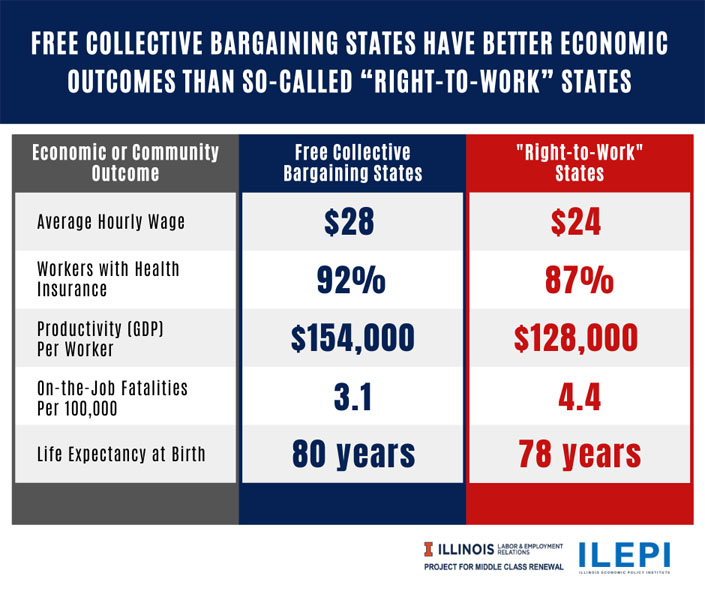NATIONAL
New study: ‘Right to Work’ states underperform in multiple areas
National study finds ‘Right to Work’ states have worse economic, health, social, and civic outcomes
 LA GRANGE, Ill. (Feb. 10, 2021) — In an eight-year period of national economic expansion that followed the Great Recession of 2008, the 27 U.S. states that had enacted so-called “right-to-work” laws saw slower economic growth, lower wages, higher consumer debt, worse health outcomes, and lower levels of civic participation than states that had not, according to a new study by the Illinois Economic Policy Institute (ILEPI) and the Project for Middle Class Renewal (PMCR) at the University of Illinois at Urbana-Champaign.
LA GRANGE, Ill. (Feb. 10, 2021) — In an eight-year period of national economic expansion that followed the Great Recession of 2008, the 27 U.S. states that had enacted so-called “right-to-work” laws saw slower economic growth, lower wages, higher consumer debt, worse health outcomes, and lower levels of civic participation than states that had not, according to a new study by the Illinois Economic Policy Institute (ILEPI) and the Project for Middle Class Renewal (PMCR) at the University of Illinois at Urbana-Champaign.
Read the report: Promoting Good Jobs and a Stronger Economy: How Free Collective-Bargaining States Outperform “Right-to-Work” States
So-called “right-to-work” laws prohibit clauses in union contracts that require all workers covered by the contract to share in the costs of collective bargaining. By forcing more unions to provide services for free, “right-to-work” laws substantially reduce the resources these organizations have available to organize, negotiate, and advocate on behalf of working families.
“For years, anti-union zealots have presented so-called ‘right-to-work’ laws as a panacea to growing the economy,” said study co-author Frank Manzo IV. “Yet surveys of CEOs say ‘right-to-work’ has little effect on business relocation decisions, and the data shows that so-called ‘right-to-work’ states are performing substantially worse than their peers on wages, growth, poverty, and other core economic outcomes.”
The comprehensive comparative study utilized eight years of data from the American Community Survey, U.S. Department of Labor, U.S. Department of Commerce, Federal Reserve Bank of New York, University of Washington’s Institute for Health Metrics and Evaluation, and the Centers for Disease Control and Prevention (CDC). Researchers used state-level weighting based on population or employment and advanced statistical regressions to isolate the impact of “right-to-work” laws on states and households during the eight years of economic expansion that followed the Great Recession.
“Beyond the core economic indicators, the data also correlates free collective-bargaining states—or states with stronger union security agreements—with better quality of life outcomes both inside and outside of the workplace,” said study co-author, PMCR Director, and University of Illinois Professor Dr. Robert Bruno. “When workers have a stronger voice to bargain for better wages, benefits, training, and safety measures, it produces long-term dividends in the form of enhanced productivity, improved community health, and higher civic participation. A rising tide lifts all boats.”
Researchers noted that while the distinctions between “right-to-work” and free collective-bargaining states are substantial looking at the economy and communities as a whole, they are even more significant when examined through the narrower lens of traditionally-unionized occupations performing essential functions during the COVID-19 pandemic.
“As we seek out ways to value and support the front-line workers who are keeping our communities going during these historically challenging times, there is ample evidence to suggest that ‘right-to-work’ laws are having the opposite effect,” Dr. Bruno added.
Economic research has long associated “right-to-work” laws—and the well-financed interests that have lobbied for them—with declining union membership. Five additional states enacted “right-to-work” policies (Indiana, Michigan, Wisconsin, Kentucky, and West Virginia) between 2012 and 2017. In 2018, the U.S. Supreme Court overturned a decades-long precedent in support of union security clauses in the case of Janus vs. AFSCME Council 31, effectively imposing “right-to-work” conditions on all public sector employees nationwide.
Efforts to push new “right-to-work” laws are currently underway in at least two additional states — Montana and New Hampshire. Yet among twenty economic and community outcomes detailed in the report, both states currently outperform their “right-to-work” peers on at least 75% of the metrics.
A bipartisan federal law that passed the U.S. House of Representatives in early 2020, called the Protecting the Right to Organize (PRO) Act, includes a provision that would repeal all state “right-to-work” laws.
“A growing number of leaders in both parties have recognized that ‘right-to-work’ laws fail to deliver any broad-based economic or social benefits,” Manzo concluded. “Indeed, the data shows that shrinking the voices of workers only serves to suppress growth and eliminate access to good, family-sustaining jobs at a time when our nation is in dire need of both.”
The Illinois Economic Policy Institute (ILEPI) is a nonpartisan nonprofit organization which uses advanced statistics and the latest forecasting models to promote thoughtful economic growth for businesses and working families.
The Project for Middle Class Renewal (PMCR) at the University of Illinois at Urbana-Champaign investigates the working conditions of workers in today’s economy to elevate public discourse aimed at reducing poverty, create more stable forms of employment, and promote middle-class jobs.







